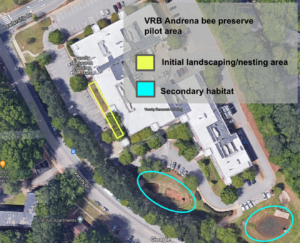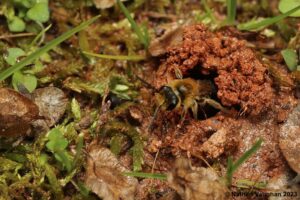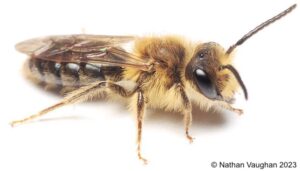What is the VRBees Project?

The VRBees Project is a research and landscape design project created with the aim to research and preserve a population of native ground-nesting bees, Andrena barbara (Barbara’s miner bee). These bees are nesting in individual cells outside Varsity Research Building, a building on NC State’s campus that is home to the Department of Entomology and Plant Pathology. This project is led by Dr. Jennie Fagen, with elements of the project led by three interns: Esme Chiara, Max O’Connor, and Jared Spurlin.
Goals

- Create a pollinator garden to help the A. barbara population sustain itself, as well as attract other native pollinators.
- Estimate the current population size and density of A. barbara on the nesting site.
- Determine the current plant species around the Varsity Research Building that are being pollinated by A. barbara.
- Determine some of the factors that influence A. barbara nesting habitat preferences
About Andrena barbara (Barbara’s miner)

Andrena barbara (A. barbara) is a species of solitary ground-nesting bee native to eastern United States. One of over 1500 species in the Andrena genus, A. barbara is commonly known as “Barbara’s miner.” The adult stage of this species is thought to occur in late February-April, which is earlier than that of their European honeybee cousins. An adult female’s life is spent collecting pollen for their offspring and storing it in individual cells, most commonly found in areas where there is bare and sunny soil. Larvae hatch and remain underground until they pupate and reach adulthood.
Andrena barbara is a generalist pollinator thought to be a useful co-pollinator of fruit trees, as well as one of the first pollinators of the season for plants that bloom early in the spring. Despite being solitary, they are often found aggregating in large numbers in the same area. However, they are not aggressive nest defenders and are generally docile.